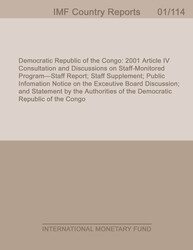
Honduras: Debt Sustainability Analysis 2006
Volume/Issue:
Volume 2006
Issue 442
Publication date: December 2006
ISBN: 9781451817195
$20.00
Add to Cart by clicking price of the language and format you'd like to purchase
Available Languages and Formats
| English |
Prices in red indicate formats that are not yet available but are forthcoming.
Topics covered in this book
This title contains information about the following subjects.
Click on a subject if you would like to see other titles with the same subjects.
Exports and Imports , Public Finance , ISCR , CR , Real GDP growth , U , S , dollar , current account , NPV of debt-to-revenue ratio , GDP deflator , long-term debt , HIPC debt relief , NPV of debt-to-GDP ratio , NPV of debt-to-revenues ratio , NPV terms , NPV of debt-to-revenue increase , sustainability Framework , Debt relief , Debt burden , Export performance , Central America
Also of interest
Summary
In the IMF staff’s view, Honduras’s debt is subject to a moderate risk of distress. The framework follows a methodology for assessing the risk of debt distress in low-income countries (LICs), guided by indicative, country-specific external debt burden thresholds derived from the empirical finding that sustainable debt levels for LICs increase with the quality of policies and institutions. The debt sustainability analysis (DSA) is based on various assumptions. The evolution of the domestic debt has also improved. Two major exogenous factors and one policy assumption underlie the macroeconomic framework of the baseline scenario.
Copyright © 2010 - 2025
Powered by:
AIDC



